Themed collection International Year of Crystallography Celebration: Asia-Pacific

2014 International year of crystallography celebration: Asia-Pacific
Welcome to this CrystEngComm themed issue celebrating the 2014 International Year of Crystallography in the Asia-Pacific region.

CrystEngComm, 2014,16, 6276-6276
https://doi.org/10.1039/C4CE90077D
Structural design and electronic properties of halogen-bridged mixed-valence ladder systems with even numbers of legs
We present an overview of new series of halogen-bridged mixed-valence ladder materials with even numbers of legs.
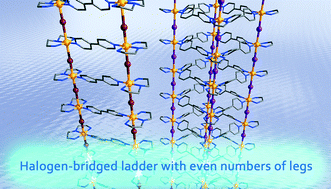
CrystEngComm, 2014,16, 6277-6286
https://doi.org/10.1039/C4CE00634H
A new family of zinc metal–organic framework polymorphs containing anthracene tetracarboxylates
Subtle difference in synthesis conditions has resulted in a family of zinc metal–organic framework polymorphs containing anthracene tetracarboxylates.
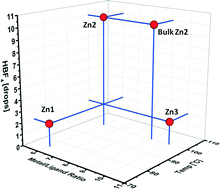
CrystEngComm, 2014,16, 8937-8940
https://doi.org/10.1039/C4CE00385C
Formation of a non-porous cobalt-phosphonate framework by small pH change in the preparation of the microporous STA-16(Co)
The initial pH of the suspension was found to determine whether the porous STA-16(Co) phase or a non-porous Co(II)-phosphonate pillared layer structure was formed.
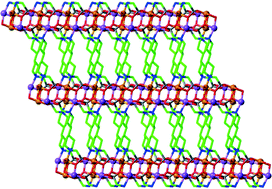
CrystEngComm, 2014,16, 6296-6299
https://doi.org/10.1039/C4CE00509K
ROD-8, a rod MOF with a pyrene-cored tetracarboxylate linker: framework disorder, derived nets and selective gas adsorption
Reported here is a new CdII-based metal–organic framework (MOF), ROD-8, based on the rod secondary building unit (SBU) and tetratopic linker 1,3,6,8-tetrakis(p-benzoic acid)pyrene.
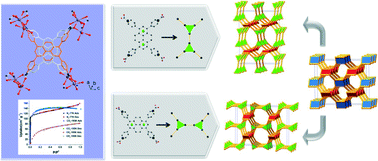
CrystEngComm, 2014,16, 6291-6295
https://doi.org/10.1039/C4CE00279B
A nitro-decorated NbO-type metal–organic framework with a highly selective CO2 uptake and CH4 storage capacity
A nitro-decorated and highly porous metal–organic framework with NbO topology was reported, exhibiting good adsorption selectivity of CO2/CH4 (8) and CO2/N2 (24) at 273 K and 1 bar, high methane total uptake of 184 cm3 cm−3 at 290 K and 35 bar.
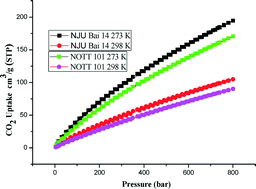
CrystEngComm, 2014,16, 6287-6290
https://doi.org/10.1039/C4CE00202D
Luminescent lanthanide-2-phenylpyrimidine-carboxylate frameworks: structure and luminescence tuning
Six lanthanide–organic frameworks with diverse structural motifs are constructed and their photoluminescence behavior is notably dependent on the structural characteristics.

CrystEngComm, 2014,16, 6483-6490
https://doi.org/10.1039/C4CE00360H
Photoluminescent 3D lanthanide MOFs with a rare (10,3)-d net based on a new tripodal organic linker
Isomorphous Ln-MOFs with a rare (10,3)-d network were assembled from a dual functional ligand which sensitizes Ln-based luminescence, achieving high quantum yield for Tb-MOF.
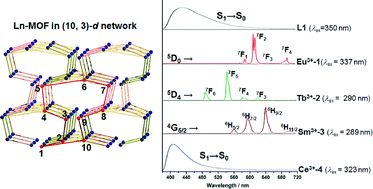
CrystEngComm, 2014,16, 6469-6475
https://doi.org/10.1039/C4CE00586D
The influence of anion, ligand geometry and stoichiometry on the structure and dimensionality of a series of AgI-bis(cyanobenzyl)piperazine coordination polymers
Five AgI coordination polymers based on cyanobenzyl-functionalised piperazines are reported and structurally analysed.

CrystEngComm, 2014,16, 6459-6468
https://doi.org/10.1039/C4CE00816B
Cobalt(II), iron(II), zinc(II) and palladium(II) complexes of di-topic 4′-{4-[bis(2-pyridyl)aminomethyl]phenyl}-2,2′:6′,2′′-terpyridine. Synthetic and X-ray structural studies
A new di-topic hybrid ligand incorporating terpy/dpa domains and the X-ray structures of five of its metal complexes are presented.
![Graphical abstract: Cobalt(ii), iron(ii), zinc(ii) and palladium(ii) complexes of di-topic 4′-{4-[bis(2-pyridyl)aminomethyl]phenyl}-2,2′:6′,2′′-terpyridine. Synthetic and X-ray structural studies](/en/Image/Get?imageInfo.ImageType=GA&imageInfo.ImageIdentifier.ManuscriptID=C4CE00414K&imageInfo.ImageIdentifier.Year=2014)
CrystEngComm, 2014,16, 6476-6482
https://doi.org/10.1039/C4CE00414K
Synthon polymorphs of 1 : 1 co-crystal of 5-fluorouracil and 4-hydroxybenzoic acid: their relative stability and solvent polarity dependence of grinding outcomes
Two synthon polymorphs of 1 : 1 co-crystals of 5-fluorouracil and 4-hydroxybenzoic acid were synthesized, and the crystal structures were determined.

CrystEngComm, 2014,16, 6450-6458
https://doi.org/10.1039/C4CE00221K
Five Cd(II) coordination polymers based on 2,3′,5,5′-biphenyltetracarboxylic acid and N-donor coligands: syntheses, structures and fluorescent properties
Five Cd(II) coordination polymers based on 2,3′,5,5′-biphenyltetracarboxylic acid and different bis(imidazole) ligands have been synthesized.
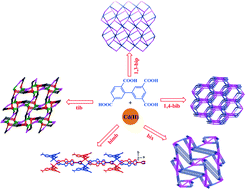
CrystEngComm, 2014,16, 6417-6424
https://doi.org/10.1039/C4CE00355A
A series of metal–organic frameworks based on a semi-rigid bifunctional ligand 5-[(1H-1,2,4-triazol-1-yl)methoxy] isophthalic acid and flexible N-donor bridging ligands
A series of MOFs based on a semi-rigid bifunctional ligand and N-donor bridging ligands have been prepared and their properties have been studied.
![Graphical abstract: A series of metal–organic frameworks based on a semi-rigid bifunctional ligand 5-[(1H-1,2,4-triazol-1-yl)methoxy] isophthalic acid and flexible N-donor bridging ligands](/en/Image/Get?imageInfo.ImageType=GA&imageInfo.ImageIdentifier.ManuscriptID=C3CE42625D&imageInfo.ImageIdentifier.Year=2014)
CrystEngComm, 2014,16, 6380-6390
https://doi.org/10.1039/C3CE42625D
Four cluster-containing highly connected coordination networks: syntheses, structures, and properties
Four cluster-containing highly connected coordination networks have been prepared under hydrothermal conditions, and their photoluminescence has been investigated.
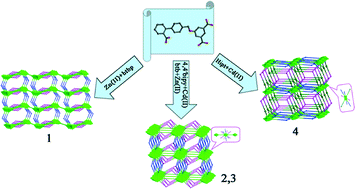
CrystEngComm, 2014,16, 6372-6379
https://doi.org/10.1039/C4CE00098F
Synthesis, structures and luminescent properties of lanthanide coordination polymers involving biphenyl-3,4′,5-tricarboxylate
A series of lanthanide coordination polymers: {[Ln2(BPT)2(DMF)(H2O)3]∙2DMF∙3H2O}n [Ln = Ce (1), Pr (2) and Eu (3)], {[Ln2(BPT)2(DMA)2(H2O)3]∙0.5DMA∙2.5H2O}n [Ln = La (4), Sm (5), Eu (6) and Tb (7)] and {[Ln(BPT)(DMSO)2]∙H2O}n [Ln = Sm (8) and Nd (9)] have been constructed by biphenyl -3, 4’, 5-tricarboxylate (H3BPT).
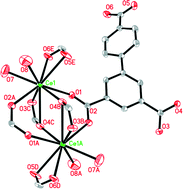
CrystEngComm, 2014,16, 6425-6432
https://doi.org/10.1039/C4CE00158C
Cyanide-bridged bimetallic 3D Hoffman-like coordination polymers with tunable magnetic behaviour
Two isostructural cyanide-bridged bimetallic coordination polymers with a 3D doubly interpenetrated Hoffman-like network exhibit complete two-step spin-crossover behaviours.
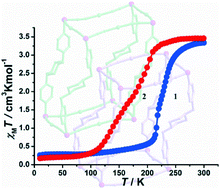
CrystEngComm, 2014,16, 6444-6449
https://doi.org/10.1039/C4CE00342J
Structural diversity of 5-methylnicotinate coordination assemblies regulated by metal-ligating tendency and metal-dependent anion effect
The diverse structures of coordination assemblies based on 5-methylnicotinate can be finely controlled by metal centers and the metal-dependent anion effect.
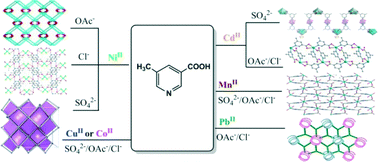
CrystEngComm, 2014,16, 6433-6443
https://doi.org/10.1039/C4CE00187G
Guest dependent dielectric properties of nickel(II)-based supramolecular networks
Nickel-based supramolecular compounds exhibit interesting guest dependent dielectric behaviour and high thermal stability. This study serves as a motivation to expand our research to create both high and low-κ materials with a judicious selection of guest molecules.

CrystEngComm, 2014,16, 6309-6315
https://doi.org/10.1039/C4CE00218K
On the role of DMSO-O(lone pair)⋯π(arene), DMSO-S(lone pair)⋯π(arene) and S![[double bond, length as m-dash]](https://www.rsc.org/images/entities/char_e001.gif) O⋯π(arene) interactions in the crystal structures of dimethyl sulphoxide (DMSO) solvates
O⋯π(arene) interactions in the crystal structures of dimethyl sulphoxide (DMSO) solvates
DMSO-O(lone pair)⋯π(arene), DMSO-S(lone pair)⋯π(arene) and S![[double bond, length as m-dash]](https://www.rsc.org/images/entities/char_e001.gif) O⋯π(arene) interactions are found in DMSO solvates.
O⋯π(arene) interactions are found in DMSO solvates.
![Graphical abstract: On the role of DMSO-O(lone pair)⋯π(arene), DMSO-S(lone pair)⋯π(arene) and S [[double bond, length as m-dash]] O⋯π(arene) interactions in the crystal structures of dimethyl sulphoxide (DMSO) solvates](/en/Image/Get?imageInfo.ImageType=GA&imageInfo.ImageIdentifier.ManuscriptID=C4CE00305E&imageInfo.ImageIdentifier.Year=2014)
CrystEngComm, 2014,16, 6398-6407
https://doi.org/10.1039/C4CE00305E
Utilising hinged ligands in MOF synthesis: a covalent linking strategy for forming 3D MOFs
A strategy to covalently connect 2D MOFs by ligand design is reported that yields 3D MOFs topologically-related to the 2D structures without the need for a second ‘pillaring link’.
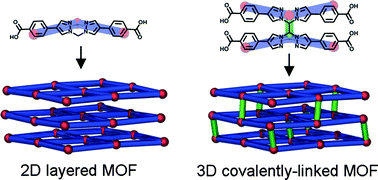
CrystEngComm, 2014,16, 6364-6371
https://doi.org/10.1039/C4CE00181H
Novel coordination polymers of Zn(II) and Cd(II) tuned by different aromatic polycarboxylates: synthesis, structures and photocatalytic properties
Six fascinating coordination polymers (CPs) showed good photocatalytic activities for the degradation of methylene blue (MB).
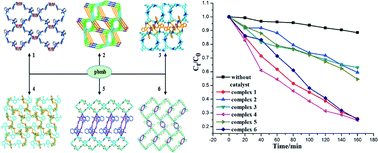
CrystEngComm, 2014,16, 6408-6416
https://doi.org/10.1039/C4CE00093E
Isoreticular MOFs based on a rhombic dodecahedral MOP as a tertiary building unit
The reactions of a Zn(II) ion with ligands containing two 1,3-benzene dicarboxylate residues resulted in isoreticular MOFs based on a rhombic dodecahedral MOP, in which the MOP was built using [Zn2(COO)4] clusters as a 4-c SBU and [Zn2(COO)3] clusters as a 3-c SBU.
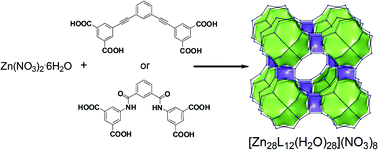
CrystEngComm, 2014,16, 6391-6397
https://doi.org/10.1039/C4CE00017J
Ligand geometry-directed assembly of seven entangled coordination polymers
Seven M(II) coordination polymers were prepared and the photocatalytic activities of some of them were explored.
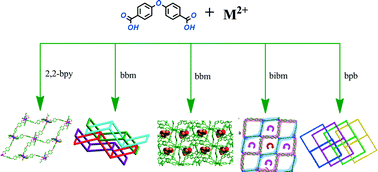
CrystEngComm, 2014,16, 6354-6363
https://doi.org/10.1039/C3CE42545B
Use of the oxime–oximato binding mode to stabilise mixed valence copper iodide polymer networks using dipyridyl ketone oxime ligands
Coordination polymers formed from copper iodide and four isomeric dipyridyl ketone oxime ligands showed the importance the oxime–oximato bridge on the formation of mixed valence Cu(I)/Cu(II) polymers.
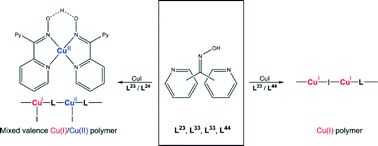
CrystEngComm, 2014,16, 6345-6353
https://doi.org/10.1039/C3CE42481B
A Mn(II) coordination framework incorporating the redox-active tris(4-(pyridin-4-yl)phenyl)amine ligand (NPy3): electrochemical and spectral properties
Investigation of the electronic and spectral properties of a redox-active Mn2+ coordination framework revealed the accessibility of the oxidised state of the framework upon oxidation.
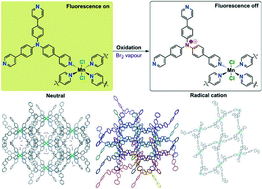
CrystEngComm, 2014,16, 6331-6334
https://doi.org/10.1039/C3CE42603C
Synthesis, characterization and selective hysteretic sorption property of metal–organic frameworks with 3,5-di(pyridine-4-yl)benzoate
Three new metal–organic frameworks with different topologies were synthesized and characterized. The Co(II) framework shows selective and hysteretic sorption of carbon dioxide.
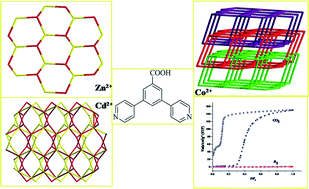
CrystEngComm, 2014,16, 6300-6308
https://doi.org/10.1039/C3CE42260G
The diversity of Zn(II) coordination networks composed of multi-interactive ligand TPHAP−via weak intermolecular interaction
Seven types of different Zn(TPHAP) coordination networks were prepared thanks to the excellent multi-interactivity of TPHAP via weak intermolecular interactions.
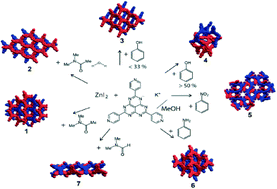
CrystEngComm, 2014,16, 6335-6344
https://doi.org/10.1039/C3CE42382D
New porous coordination polymers based on expanded pyridyl-dicarboxylate ligands and a paddle-wheel cluster
Combining pyridyl-dicarboxyl ligands and the classic Cu2(RCOO)4(py)2, three new flexible porous coordination polymers with 3D (3,6)-connected rtl, eea and pyr networks have been constructed and characterized.
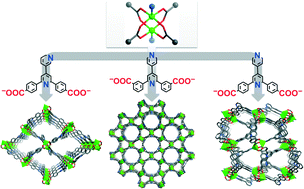
CrystEngComm, 2014,16, 6325-6330
https://doi.org/10.1039/C3CE42219D
Assembly of organometallic networks with multinuclear silver(I)–ethynediide supramolecular synthon, trifluoroacetate and ligands derived from isomeric dicyanobenzenes
Silver ethynediide complexes feature infinite chains composed of C2@Agn units bridged into two- or three-dimensional coordination networks by dicyanobenzene derivatives.

CrystEngComm, 2014,16, 6316-6324
https://doi.org/10.1039/C3CE41671B
About this collection
CrystEngComm is celebrating the 2014 International Year of Crystallography (IYCr) with a series of themed issues focusing on crystal engineering research from around the world.
Guest edited by Stuart Batten and Jagadese Vittal, the Asia-Pacific issue highlights some of the latest research from this community.